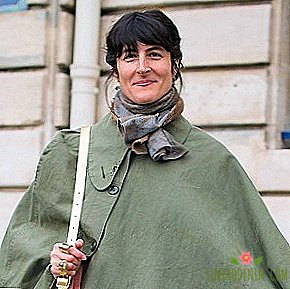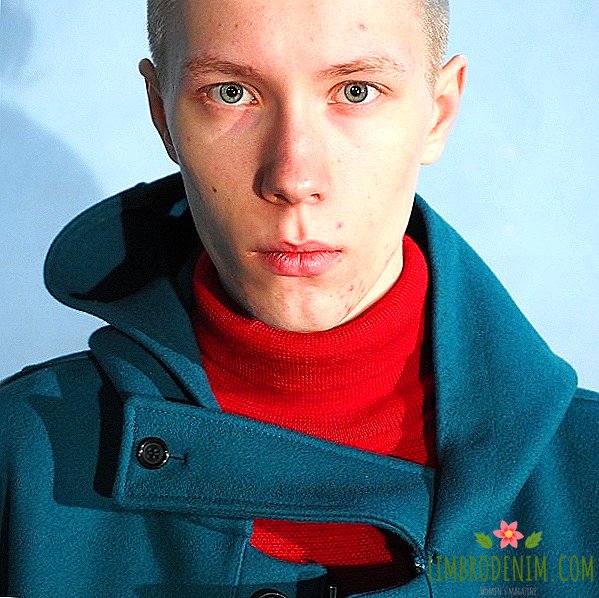Vestoj: Anya Aronovski-Kronberg on how to make an independent fashion magazine
GRADUATE OF CENTRAL SAINT MARTINS AND ROYAL COLLEGE OF ARTSa native of Sweden, Anya Aronovski-Kronberg - perhaps one of the most important figures of modern independent fashion journalism. Her magazine Vestoj (read "Veda", translated from Esperanto as "clothing"), published under the auspices of the London College of Fashion, considers fashion in the context of world culture; This is a platform for discussions between theorists and practitioners, where not only fashion industry representatives, but also museum staff, industrial designers, sociologists and researchers from various fields are attracted to writing materials. It is noteworthy that in Vestoj there is no advertising: the publication has a paper version, which is published once a year, and a website.
Anya came to Moscow to give a lecture at the BE-IN OPEN forum of new fashion industry. Anya meets me in a cafe not alone - she has a daughter Calisto in her arms, who desperately asks for food. “She likes Moscow, she’s just very tired now and she’s hungry because we are on the road all day,” the journalist explains. Anya David’s husband is sitting next to her — she jokingly calls him a “gray cardinal,” because she sometimes turns to him for advice. David is an architect by profession and often does set-up at Vestoj events. After Calisto ate and fell asleep in Mom's arms, we begin the interview.

About Moscow
The decision to go to Moscow was spontaneous: I knew almost nothing about this city, but when I was invited to give a lecture, I immediately agreed - out of curiosity. In the end, we came with the whole family: me, David and our daughter Calisto. This trip is an introductory trip, so far we have only seen a few large stores: TsUM, KM20, GUM - the latter has especially impressed me with its scale. First of all, I wanted to learn more about the state of modern Russian fashion, find out whether local designers want to enter the international market or plan to develop here.
About the background and Vestoj
I graduated from Central Saint Martins School of Fine Arts in London, and then I went to the magistracy in design history at the Royal College of Art. It became interesting to look at the fashion industry in the context of philosophy, sociology and anthropology - I soon learned that for this purpose there is a whole discipline and academic community that deals only with this. After studying, I got the position of editor at Acne Paper, but after a couple of years I realized that it was time to move on. Acne Paper was the brainchild of Thomas Persson (chief editor. - Ed.) and john johansson(creative director. - Ed.) - when you work in this edition, you begin to understand that you need to meet the concept and expectations of its creators.
At that moment I already wanted to do something of my own, to find my niche. I often wondered how it would be possible to combine theoretical and practical approaches to fashion - this is how Vestoj appeared. It was easy to find authors - in the scientific community there are many who want to go beyond the academic community and publish works in a beautiful journal. It was much harder to find the right tone. I did not want scientists to use terms that are incomprehensible to others: Vestoj, of course, is not a mainstream publication, but I wanted the journal to be understandable not only for an academic audience. I always use a light syllable and humor to make it interesting for people to read, I choose a lot of illustrations and I divide especially voluminous texts into blocks.
In addition, I try to remember that not all readers know, for example, who Michel Foucault is, so every name and term in Vestoj will definitely have an explanation. The whole point of my journal is to introduce the theory of those who know almost nothing about it, and not to make people feel stupid. I also try to attract as authors industry professionals who could write about their work in a critical manner. By the way, I myself consider myself a part of the industry rather than a scientist, although I remain a research assistant at the London College of Fashion.
About authenticity
For each issue, I choose a topic, guided exclusively by my intuition. I don’t know how clear my logic is for the rest, but each new topic follows in its own way from the old and allows us to look at fashion from a new angle. The leitmotifs of the previous issues were masculinity, shame, strength. The new general idea is capital, but I have not yet had time to think about the release plan: while I am on maternity leave.
As for the current issue, its theme is authenticity. I constantly see how fashion marketers use the terms "craftsmanship", "handmade", "legacy" and other words that directly relate to the concept of authenticity. But what motivates them to attach such importance to this? And anyway, is it possible to be “authentic” in fashion or such a thing no longer exists? From the point of view of the industry, an authentic designer is the one who understands the codes of the subordinate brand best of all, but the fashion is constantly changing, and the concepts are with it. Therefore, I decided to push readers to reflect on the meaning of this word in our era. For this, I used a variety of formats: prose, poetry, historical and scientific essays, photography and others - all the articles are absolutely invaluable.
About honesty in fashion journalism
My example is the exception rather than the rule. On the one hand, there is no advertising in Vestoj, so I don’t need to write articles of praise for brands to love me, this gives a certain freedom. On the other hand, I do not want to become an outsider in the industry. Unlike scientists, who can address any topic without fear of losing the location of colleagues, it is important for me not to lose access to people. This is a kind of dance with power: although I do not need money for the publication of Vestoj, I want to be part of this circle so that my work remains relevant. Therefore, sometimes I also touch on those who would be interested in a wider audience - for example, interviewing major designers, although I could only talk about small independent brands.
Our main difference, for example, from Vogue, is that I try to push the interviewee to a critical assessment of his work. But sometimes you have to include self-censorship - for example, in those cases when I know that my interlocutor may regret what he has said. Then I figure out how important this wording is for the article and whether it is worth it to make enemies for myself. At some point, every fashion journalist decides for himself whether to resort to self-censorship or not. In the end, we are not reporters - we are storytellers, which means that everyone chooses the narrative of history. Can this be considered fair journalism? At the same time, I would never promote someone's product — I am not a press attache.
About Lucinda Chambers
I knew that the story of Lucinda Chambers would stir up the industry, but I couldn’t even imagine how strong(Lucinda Chambers is the former fashion director of the British Vogue. She was forced to leave the publication in July 2017, after which she gave a frank interview to Vestoj, in which she sounded the real reasons for her dismissal. The article caused a big stir and almost immediately after the publication was removed under pressure from Condé Nast. The interview reappeared on the site only the next day - but now in an edited version - Ed.). At that moment I thought that Lucinda had just voiced the well-known facts to everyone - that which she whispered on the sidelines, but did not speak publicly. Immediately after publication, I received a letter from Condé Nast demanding that I delete the interview. It was already the end of the working day, I was at a loss and did not have time to consult with lawyers, so I decided that it would be easier to make a concession.
I will not hide that at that moment I was terribly frightened. It was not an ideological question that stood before me, but a practical one: how much time would be spent on the courts, how much money it would take, and so on. The next morning I received a new letter - this time the representatives of Condé Nast wrote that everything is in order and I can leave the material on the site if I correct a few formulations. First of all, those related to the circumstances in which Lucinda Chambers left the publishing house. The word "fired" was more emotional than truthful - while Condé Nast insisted that the company complied with the necessary procedure. Lucinda can be understood, but the publishing house, too: it was important for them to convey that everything happened according to the rules. I had a little time to think, but I agreed, because I knew that the general message of the article would still remain the same. The material was not on the site for only one night, but its disappearance caused even greater resonance. Condé Nast it was completely unprofitable, while this situation was good for me - after that, everyone began to talk about Vestoj.
This situation has taught me a lot. When I first started working on Vestoj, I thought that big corporations were evil. Over time, I realized that this is too simplistic approach. Of course, when the story of Lucinda unfolded, I was terribly annoyed by the pressure from a large company. Now I have come to the conclusion that this is only a matter of perspective and of the agenda - each has its own. And even if the position of Condé Nast was contrary to my opinion, it was just their agenda, and I, as a journalist, had to remain objective.
About paper magazines and live events
Being a publisher and editor-in-chief of Vestoj, I don’t worry about the future of the paper press. I know that I have my own niche and my readers who are ready to buy a magazine, mostly industry professionals and opinion leaders. Vestoj is published once a year, so I try to make the publication beautiful, pleasant to the touch, so that it can be proudly stored on the shelf among the books and re-read with pleasure. Such journals require more thoughtfulness, while the online edition is still about speed. For example, if I decided to print an interview with Lucinda in the paper version of Vestoj, it would have long since lost relevance. On the site, I try new authors - most often they are young journalists who still have not so much experience. As for social networks, so far I do not see much sense in them - after all, I am from another generation; although maybe the whole thing is that I just don’t spend enough time in them.
What interests me the most is living events - a wonderful old school format. Most of all I like the fact that it is the exact opposite of the digital that has captured everything today. I enjoy real meetings, communication, I like to see human emotions - here and now. Once I even vetoed the use of devices on the event - it was just necessary, because the whole point was to get people involved in what was happening, in the history of the speakers. Vestoj events have their own philosophy: they need to be present. And if someone can not come, then nothing terrible, will be next time.
My favorite format is when participants tell stories about things with which they have special memories. Most of all I remember the PS1 event, which David and I were doing at the New York MoMA Museum. In general, David is my gray cardinal, he gives me good advice, and we do many events together. I am engaged in communications, and he is a set-design. This event was a reason to work together again, in a foreign city, but with amazing speakers and a familiar format. We've got a very mixed lineup: Dapper Dan designer, model Pat Cleveland, costume designer for the Sex and the City series Patricia Field, Mary McFadden designer, writer and first editor of Interview Glenn O'Brien, and Vogue editor Candy Pratts Price. Each of the participants told the story of a favorite thing in the context of an era and region. It was a kind of tour of New York through time: Patricia Field talked about the Queens of the 50s, Dapper Dan - about Harlem the 80s and so on.
Many stories were very personal, people shared their secrets. It is much easier to do this when only a few people listen to you - going back to the topic of banning devices. Few people want to pour out their souls when twenty people are sitting in front of you with cameras. This confuses. I wanted the listeners not to be distracted by the shooting, but to be completely immersed in the stories, to feel them. So many times I was at events that seemed to be arranged only to make beautiful photos and videos and then show off to my friends. There you seem to be a member of the crowd, but you are not paid for it. I plan to hold more such meetings: it is better to see and hear in person than to watch photo reports.
About tips for young journalists
The main thing that I can advise young journalists is to be patient and not wait for quick results. So you will be less upset. Vestoj is a matter of my life, more an art project than just a magazine. I take my work to heart and I know that I will do it, no matter what happens - no matter how much money I have and whether there is funding. Therefore, I wish young journalists to find their place and confidently do their work, no matter how popular or unpopular it is.
Photo: Getty Images (1), Tenderbooks





